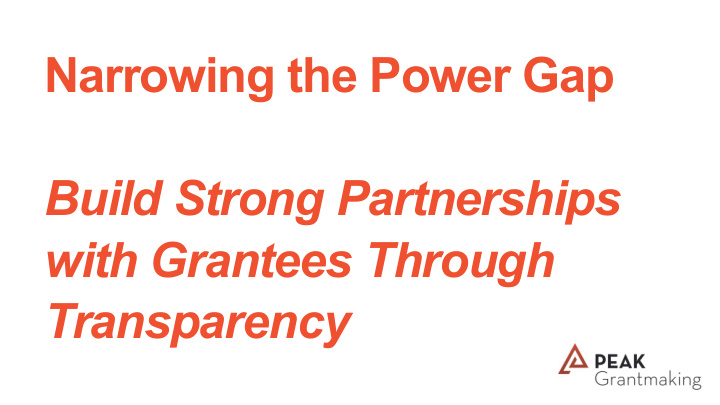



Narrowing the Power Gap Build Strong Partnerships with Grantees Through Transparency
• Narrow the Power Gap – Three Recommendations • Transparency Agenda • 30-Second Case Stories • Local Case Stories • Breakout Discussions • Regroup • Farewell!
About PEAK Grantmaking A community of more than 4,500 … to improve how grants get made grantmakers coming together…
Power: • Possession of control, authority or influence over others • Also: jurisdiction, command, sway, dominion, grip, force, strength, might, etc.
“Power, whether through organized people or organized money, is the force that changes systems, and changing systems is the only way to achieve equitable outcomes for all communities. As a grantmaker, you cannot truly strive for and advance equity until you understand your own power and privilege in society and in relation to your grantees. Then you can make conscious choices about how to use that power to be more effective and have lasting positive impact, in ways that align with the goals, needs and strategies of the communities you seek to benefit.” Source : Power Moves , National Committee for Responsive Philanthropy
How to Narrow the Power Gap: 1.Build strong and trusting relationships with your grantees. 2.Rightsize the grantmaking process and implement flexible practices to reduce the time and burden on your grantees. 3.Structure grant awards to be more responsive to grantseeker needs.
Recommendation: Build strong and trusting relationships with your grantees Resources: How to be Transparent, Clear and Responsive with Your Grantees How to Design Accessible and User-Friendly Online Systems How to Collect and Act on Community Feedback
Be clear, responsive and transparent with your grantees.
Design online application and reporting systems that are accessible and user-friendly.
Solicit direct, confidential feedback and then act transparently to improve.
Recommendation: Rightsize the grantmaking process and implement flexible practices to reduce the time and financial burden on your grantees. Resources : How to Rightsize the Grantmaking Process and Implement Flexible Practices NetGrant Calculator
Know the Net Grant and keep it high.
Rightsize your application and reporting processes and requirements.
Be flexible with financial and program information.
Recommendation: Structure grant awards to be more responsive to grantseeker needs Resource: How to Structure Grant Awards to be More Responsive to Grantseeker Needs
Provide your nonprofit partners with flexibility to adapt as their environment changes.
Consider full-cost funding or operating support grants for better outcomes.
Develop a new approach to supporting systems change work through advocacy and lobbying.
Quick Poll
Be clear, responsive and transparent with your grantees.
Transparency: • Anything an organization does to proactively communicate, explain or share information about itself with its grantseekers and the community at large. • Includes staff availability and responsiveness.
Three Types of Transparency: • Organizational Transparency—Public information about your organization, including funding priorities, staff, and current and previous grantees. • Process Transparency—Public information about processes related to applying for, receiving, and reporting on a grant. • Decision-Making Transparency—Clear and proactive communication about funding decisions and other important decisions related to the grantee.
Organizational Transparency What to Share: • See GlassPockets.org by Candid • Mission, vision, values • Key staff and board • Contact info for staff • Bylaws, charters, governance • Financials • Recently awarded grants and all previous grantees • Grantmaking focus and strategy • Diversity of board and staff
30-Second Case Story: Organizational Transparency
Process Transparency What to Share: • Grantmaking process stages • Process timeline and how long each step takes • When grantee can expect to hear from you at each stage • When grant decisions will be finalized – accountability for your team to share ASAP • How responsive grantees can expect your staff to be at any time – on what topics and how quickly
30-Second Case Story: Process Transparency
Decision-Making Transparency What to Share: • Names/descriptions of grant reviewers • Granting criteria, decision frameworks, rubrics • Funding preferences or prohibitions • Feedback on each application, what influenced final decision and suggestions for the future
30-Second Case Story: Decision-Making Transparency
Local Case Stories
Questions?
Breakouts and Group Discussion • What does your organization do that reflects a commitment to transparency? • What does your organization do that falls short? • What is one idea you heard from the case stories that you’d like to try at your organization?
Public Resources Courage in Practice: 5 Principles for Peak Grantmaking Strategies for Narrowing the Power Gap in Philanthropy
Recommend
More recommend